
 RAPID is the Authority on 3D: Printing, Scanning, and Additive Manufacturing. If you are interested in 3D Printing, then it is the one event you need to attend. Why is 3D Printing important?
RAPID is the Authority on 3D: Printing, Scanning, and Additive Manufacturing. If you are interested in 3D Printing, then it is the one event you need to attend. Why is 3D Printing important?
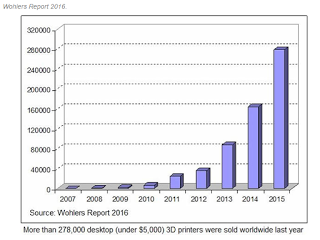
According to Wohlers Report 2016, the additive manufacturing (AM) industry, consisting of all AM products and services worldwide, grew 25.9% (CAGR) to $5.165 billion in 2015.
The CAGR for the previous three years was 33.8%. Over the past 27 years, the CAGR for the industry is an impressive 26.2%.
Why is it in Orlando, FL? Florida ranks among the nation’s top 10 states for manufacturing and is home to more than 18,600 manufacturing companies. Top manufacturing segments include advanced manufacturing, aerospace and defense products, metal fabrication, and medical equipment. Florida’s manufacturing industry is highly integrated with the global economy, with Florida-origin exports to the world reaching $58.6 billion in 2014. Manufacturing employs 336,200 people in Florida, an increase of 6,700 jobs over 2014. Florida ranks #1 for aviation manufacturing attractiveness and #5 for high-tech employment in the U.S. Orlando is a top location for entrepreneurs.
Examples of types of Additive Manufacturing.
A good overview of different types of additive manufacturing processes can be found here. Two examples from that page:
Material Extrusion (FDM)
Material Extrusion is a group of AM processes that create the final product by selectively depositing material. They do so by extruding the material through a small diameter nozzle. The base material often is a paste or a plastic. In the case of the paste a syringe type
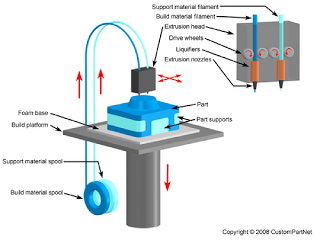
applicator can be used to deposited the paste. For plastics usually a plastic filament is fed through a heated nozzle that melts the plastic so it can be deposited.
Fused Deposition Modeling (FDM) is a process that uses a reel of plastic filament. Once deposited the filament will stick to underlying layers and neighboring filaments and will almost directly solidify. Due to the nature of the FDM process overhanging features should be held by support material.
Fused Deposition Modeling showing the part (dark blue) and support material (light blue). The extrusion head (see detailed view at the upper right) remains at the same z-level and the build platform moves to allow stacking layers.
Due to the simplicity of the layout of the process and the machine, FDM is used in preferably used in the many homebuilt AM machines like for example the RepRap and the Ultimaker.
Material Jetting (Objet, Solidscape, 3D systems)
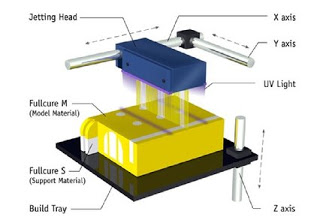
Two groups of processes are recognized that both use a jetting technology, like found in normal inkjet printers. Material Jetting is the process were the 3D printer uses an inkjet head to selectively deposit product material.
Two types of material are predominantly used in this group of processes; wax and photopolymers. Some processes are able to directly jet metals. The advantage of this group of processes is that the nature of the process allows to change the product material during a build. In this way graded material properties are possible.The material jetting system as used by Objet.
Real World 3D printing Success Stories
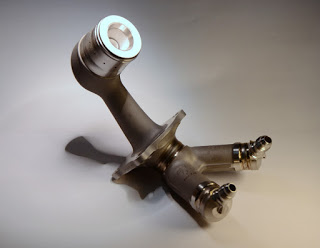
GE Fuel Nozzle – From this article
“The end result is an engineering marvel, one monolithic piece that has replicated the complex interior passageways and chambers of the old nozzle down to every twist and turn thanks to the miracle of direct metal laser melting where fine alloy powder is sprayed onto a platform in a printer and then heated by a laser, and repeated 3,000 times until the part is formed.
What makes the new nozzle so special isn’t just that it has converted a many-steps engineering and manufacturing process into just one. It is also a miracle of material science since it happens to be both 25% lighter in weight, as well as a staggering five times more durable than its older sibling, all of which translates to a savings of around US $3 million per aircraft, per year for any airline flying a plane equipped with GE’s next generation LEAP engine, developed by CFM International, a joint venture between GE and France’s Snecma (Safran).”
Why does Wenzel America go to RAPID?
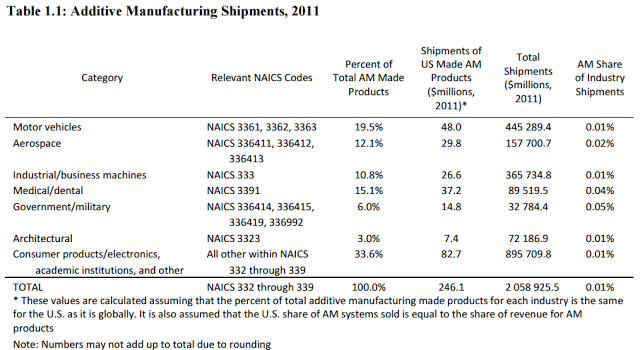
While this data from NISTs out of date, look at the % of AM parts in the industries just 5 years ago. 3D printing is becoming more and more prevalent. How do you inspect these parts to make sure they are in tolerance, that they meet the design specifications?
We do 3D Scanning. We have a variety of sensors (X-Ray, Laser, White Light) that you can use to digitize your parts. From reverse engineering, non-destructive testing to metrology, Wenzel America has a possibility of scanning your part. We already partner with companies who use subtractive manufacturing. With our diverse portfolio of metrology solutions we can also provide metrology, NDT and Reverse Engineering solutions to the Additive Manufacturing world as well.

We are at RAPID to meet you and to help you answer the questions in your manufacturing process. Giles Gaskell, Wenzel America Ltd will be presenting on May 16th, 2016. (Check the Event for specific time). This workshop provides a comprehensive introduction to 3D scanning technologies, software, and processes, highlighting the differences among data capture technologies including live hands-on demonstrations of some of the most popular scanning devices. Guest speakers and demonstrators are amongst the world’s most knowledgeable and experienced practitioners in the field. Stop by Giles’s workshop and come by our Booth 455.
